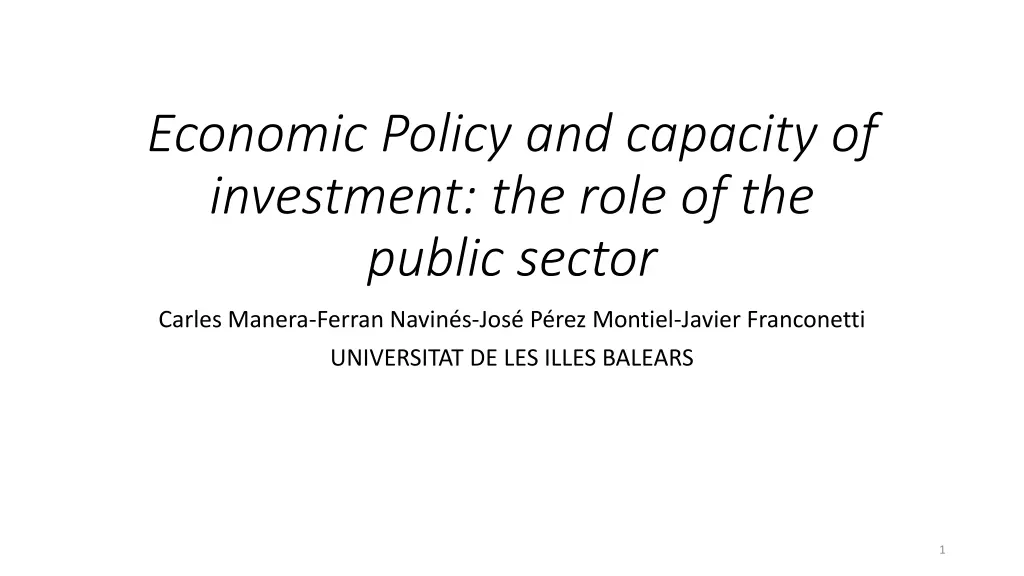
Public Sector Role in Economic Policy and Investment Capacity
Explore the intertwined nature of fiscal and monetary policies in addressing current economic challenges amidst changing times. Delve into the importance of public spending, the impact of austerity measures, and the necessity to consider individual country characteristics in economic strategies.
Download Presentation

Please find below an Image/Link to download the presentation.
The content on the website is provided AS IS for your information and personal use only. It may not be sold, licensed, or shared on other websites without obtaining consent from the author. If you encounter any issues during the download, it is possible that the publisher has removed the file from their server.
You are allowed to download the files provided on this website for personal or commercial use, subject to the condition that they are used lawfully. All files are the property of their respective owners.
The content on the website is provided AS IS for your information and personal use only. It may not be sold, licensed, or shared on other websites without obtaining consent from the author.
E N D
Presentation Transcript
Economic Policy and capacity of investment: the role of the public sector Carles Manera-Ferran Navin s-Jos P rez Montiel-Javier Franconetti UNIVERSITAT DE LES ILLES BALEARS 1
FISCAL POLICY, MONETARY POLICY Fiscal policy and monetary policy must be interwoven to face the important current economic challenges: climate change, the demographic issue and the gradual automation of production (Wolf, 2023). One avenue of work has been proposed by Mariana Mazzucato (2021): the perspective of what she calls economic missions. These missions are based on three basic pillars: 1. Fluid information, identify the most relevant information, ensure that the most prepared people can develop the project. 2. Leadership, risk taking and adaptation; importance of attracting talent. 3. Coordination of policies from different fields, to find synergies. 2
A NEW MAINSTREAM? We could talk about the configuration of a new mainstream, in line with the times of change that, apparently, are taking place. Transformations that the COVID-19 crisis has pushed, despite the enormous reluctance of conventional postulates in economics. A new order that rests on six foundations: 1. A fiscal stimulus policy, 2. The concern about deflation, apart from the obvious path towards inflation, 3. Fiscal progressivity, 4. The regulation of capital movements, 5. The existence of public deficits, 6. The increase in public debt. 3
THE IMPORTANCE OF PUBLIC SPENDING In this context, the thesis of the importance of public spending as a lever for growth has been endorsed by the IMF. Thus, the Fund's analyzes estimated that for each point of fiscal adjustment in short, a cut in public spending in developed countries, GDP contracted 0.5 points: a multiplier, therefore, very low, so that this somehow blessed the austerity policies. But the work of Olivier Blanchard, signed with Daniel Leigh, reviews in depth the original calculations of the institution and establishes new multipliers. The significance of this contribution (Blanchard-Leigh, 2013), of commendable intellectual honesty and supported by more than thirty investigations carried out between 2008 and 2012, is specified in some essential points. 4
THREE ESSENTIAL POINTS 1) In phases of depression and liquidity traps (interest rates close to zero, with little room for monetary policy), the fiscal multiplier can far exceed unity. 2) A range is established that places the multipliers, depending on the countries considered, between 0.9 and 1.7 percentage points, which concludes that the effects of austerity policies have been much more negative than expected and would explain, among other elements, the miscalculations of the institutions and, in turn, the notable growth of inequality. 3) A single recipe book is not equally acceptable to all countries; Thus, the characteristics of each of them and their different realities must be taken into account. The questioning of the application of a common template that does not distinguish particular factors underlies this review. 5
THE IMPORTANCE OF PUBLIC SECTOR Since the pandemic, the importance of public sector intervention has been capital. Fiscal stimuli have been key to avoiding a greater collapse. This is being preached by the most influential economic institutions, such as the IMF, the WB and the OECD. In Europe, the Next Generation Funds, financed for the first time by mutualizing debt, are an example of how to consider public investment as a strategy, considering responses to specific challenges: climate change, the energy transition and economic diversification. However, the war in Ukraine and geopolitical tensions are accelerating protectionist approaches and public policies protected by the principle of strategic autonomy. The abandonment of multilateral guidelines facilitates a new scenario in which the relocation of value chains is part of a rethinking of the productive specialization of countries. Free competition is subject to political decisions that define which sectors to intervene in, with what limits and in what way. States become essential actors, reinforcing the relocation and capture of industrial processes previously located in Asia and in peripheral regions to the most developed areas of the world. The strongest states take the initiative to gain advantages in leading sectors. 6
GREEN MULTIPLIERS Multipliers in investment in low-carbon activities (European country between 50-70 million inhabitants Source: Personal elaboration from: https://www.mckinsey.com/~/media/McKinsey/Business Functions/Sustainability/Our Insights/How a post-pandemic stimulus can both create jobs and help the climate/SVGZ-COVID19 -Carbon-ex1.ashx. TOTALES 2.33 Desarrollar nuevas infraestructuras de transporte: carriles-bici 2.2 Ampliar la fabricaci n de veh culos el ctricos 2.1 Ferrocarriles urbanos 2.2 Ampliar redes de carga de veh culos el ctricos 1.9 Aceleraci n en despliegue de luces LED en las calles 2.2 Aceleraci n en la construcci n de energ a e lica y solar 3.4 Ampliar el almacenamiento de energ a 3.4 Reforzar la red de distribuci n de electricidad 2.2 Instalaci n de sistemas inteligentes en los edificios 1.9 Modernizaci n de viviendas para mejoras eficiencia energ tica 2.2 Construcci n de infraestructuras de captura y almacenamiento de carbono 2.2 Mejorar la eficiencia energ tica de la industria 2.1 7
APPROACH TO A COMPARISON OF FISCAL MULTIPLIERS Source: Personal elaboration based on data from https://www.mckinsey.com/~/media/McKinsey/Business Functions/Sustainability/Our Insights/How a post-pandemic stimulus can both create jobs and help the climate/SVGZ-COVID19 -Carbon-ex1.ashx; and Blanchard-Leigh, 2013; and Portella-Carb -Deju n, 2018. Estimaciones medias Naciones Unidas 1.75 Estimaciones de Blanchard-Leigh 1.9 Actividades bajas en carbono 2.33 China 1.85 Francia 1.82 Italia 2.09 Alemania 1.72 Espa a 2.14 Reino Unido 1.85 Estados Unidos 3.07 Eurozona 2.13 8
CONCLUSION 1: THE EUROPEAN FUTURE They urge: 1. Greater coordination between fiscal policy and monetary policy. It is not coherent to demand fiscal consolidation plans at the same time as demanding aid, subsidies and investments. 2. Lose the fear of the markets : aspects that seemed rocky have been able to be rethought (for example: the almost canonical regulation of the public deficit); understand that a stubbornness towards monetarist rigidity or budgetary orthodoxy, in times of need to reaffirm the recovery of the economies, will only make a positive projection difficult. Now, are there margins for a progressive fiscal policy? Taxes for what? These two questions are the ones that are usually cooked in the kitchens of political parties during electoral campaigns. For some, the most liberal and conservative qualifications that are usually linked the essential idea is to reduce the role of the State and put money in the hands of individuals, an axiom that is linked to this, to individual decision, to a freedom which is presumed widespread but, in reality, affects fewer people. 9
CONCLUSION 2: THE ROLE OF SOCIAL DEMOCRACY Social democracy does not have to invent deaf gunpowder, nor new stories that try to inflame the masses. It would be enough for him to recover his old ideas of justice, democracy and equity. When profound reflections are written today about the crisis of social democracy and the loss of its identity, it is important to emphasize that the key lies in that past the one that formed the Welfare State rather than in a future that we do not know. decipher, because it is impossible. Capitalist development is bringing new challenges: ecological dislocations, the aging of society, the increase in youth unemployment, the greater insertion of women in labor markets, nanotechnology, productive automation, elements that outline the challenges of new industrial revolution. Here the yarns are new, but the action of weaving should remember how it was done before: with what premises, with what objectives, on what ideology. Social democracy has historical experience, theoretical contributions, practical examples and identifiable paths. 10






















